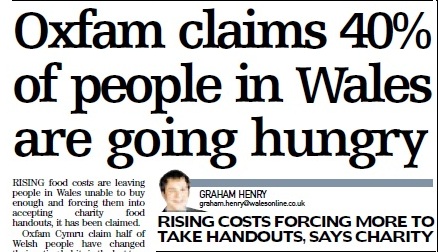Oxfam spins a tasty tale about the world's favourite food
It’s a temptation when you do a survey to pick out some morsel that will attract media attention. Oxfam seems to have fallen for this in a big way, issuing on the basis of an international survey the rather implausible claim that the world’s favourite food is pasta. It worked: the story was picked up by plenty of papers including Metro, The Independent, The Daily Express, The Belfast Evening Telegraph, and the Western Mail.
The survey was actually a more serious enterprise than the press release or the press coverage made it sound. It formed part of a campaign to highlight the rapid changes in global food consumption and the effects of rising food prices in developing and wealthy nations.
Most of the results appear sound, the outcome of an investigation covering seventeen countries with an omnibus survey combining both online, telephone and face-to-face responses. Some variation might have been introduced because completely different collection techniques were used in different countries, but there is not much reason to doubt the overall findings.
Some 16,500 people were surveyed from developed nations (including the US and the UK), emerging nations (such as India and Brazil) and developing nations (such as Kenya and Tanzania). The results indicate that there are still large numbers of people suffering from shortages of food – 54 per cent in Tanzania and Kenya say they only have enough food “some of the time”, “rarely” or “never”.
Food prices are a worry to both rich and poor, the survey found. In response to the question “which of the following two concern you most about the food your family eat?” the number of respondents picking cost varied relatively little with the level of economic development (Australia 77 per cent, Guatemala 78 per cent, Kenya 88 per cent, Mexico 84 per cent, UK 78 per cent, US 74 per cent).
More than half of respondents said that they ate differently now to how they did two years ago, with cost as the primary motivator. For example, 60 per cent of Kenyans surveyed said that changes in what they ate were as a result of cost, another 12 per cent saying that changes were caused by lower availability of certain foods.
So there’s some useful stuff in the survey, but it is let down by the section dealing with people’s favourite foods. Pasta came out on top, grabbing the headlines. The problem, though, is that this part of the survey was very poorly constructed.
It allowed respondents to choose any category of food as their favourite. So Mexican respondents chose “Mexican” as their number one choice, and Indian respondents “Indian”. In South Africa, some respondents said “curry” while others said “Indian”, two categories that overlap.
In Australia, the 15 favourites included “Italian”, “lasagne”, “pizza”, “pasta” and “spaghetti” as if they were all distinct categories. Add these together as “Italian” and Italian food would have been the overwhelming Australian choice, instead of making them look chumps by citing chocolate as their favourite food. In Russia, “delicious” food was the number 9 choice, indicating total confusion about how respondents were meant to answer the question.
In the UK, if you combine “Indian” with “curry”, it becomes the favourite food, rather than steak. I grant you that not all curries are Indian – some are Thai – but I suspect that Indian is what most UK respondents had in mind. One could multiply examples indefinitely of how muddled this survey is. But it takes up 30 pages of the 45-page report.
The confusion of categories makes the whole exercise look foolish, which is a pity. In fact, it’s a dog’s breakfast. (Since no dogs were questioned, this is in fact one of the few food categories that doesn’t make it on to the list.)
Furthermore, in Wales Oxfam Cymru said that the results showed that only 60 per cent of respondents reported having enough to eat on a daily basis, prompting the Western Mail’s headline below: “Oxfam claims 40 per cent of people of Wales are going hungry”. This was on the basis of an online survey of 1,430 people in the whole of the UK, of whom 70 per cent said they got enough to eat always, and another 23 per cent “most of the time”.

Apart from being implausible, the Welsh claim must have been based on just a handful of respondents, since the population of Wales is around 5 per cent of that of the UK. If respondents were geographically spread, that’s 72 replies, of whom (if we believe Oxfam Cymru) 28 are hungry every day.
All in all, an object lesson in how not to publicise a survey that, behind the barrage of nonsense, might contain some worthwhile information.
.




David Callam (not verified) wrote,
Thu, 23/06/2011 - 11:15
I chuckled over this - rightly or wrongly. Another fine example of the splendid work you do in sorting the statistical wheat from the chaff (no pun intended).
Thank you once again for your invaluable contribution.